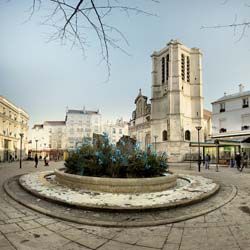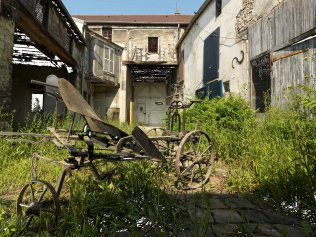 Aubervilliers offers visitors an attractive range of things to do whatever their taste and budget. Visit the church Notre-Dame-des-Vertus at Fort D’Aubervilliers, walk on the banks of the canal; wander around Stalingrad square or the beautiful town hall square. The town has 75000 inhabitants including many notable figures such as writers, painters and various artists.
Aubervilliers offers visitors an attractive range of things to do whatever their taste and budget. Visit the church Notre-Dame-des-Vertus at Fort D’Aubervilliers, walk on the banks of the canal; wander around Stalingrad square or the beautiful town hall square. The town has 75000 inhabitants including many notable figures such as writers, painters and various artists.
The name Aubervilliers appeared for the first time in 1060 in a donation deed by Henry the first to the priory of Saint-Martin des Champs in Paris. On the threshold of the twentieth century, this former small town long known for its fertile land and market-gardens and since the middle Ages; is known for its cabbage plantation in Aubervilliers and has become as famous as the peach plantation in Montreuil. Both were already linked to the nascent industrial era. Massive industries came to shape up the town as we know it today.
Wander around the town hall square, boasting terraces and a fountain sculpted by Amado. Do not miss a visit to the church Notre Dame des Vertus (XVI-XVII centuries) classified as a historical monument. On entering this place of worship, discover a stained-glass window picturing “the miracle of rain” and “the pilgrimage of Notre-Dame-des-Vertus”. Not to be missed also: the church organs of XVII-XVIII centuries; an oil on canvas painting of “the Christ in the Olives-Tree Garden” (XVIII century); a statue of the Virgin Mary and adoring angels; a sculpted hand of the fourteenth century; candles offered by Marshal Toulouse in 1336; a fifteenth or early sixteenth century sculpted keystone; a portrait of Mary of the Incarnation (XIX) and finally the upper parts of the central pillars (XIV and XV).
 Rambling around Aubervilliers may lead you to the old town house which is today the town hall where you can discover the oil on canvas: “Allegory of Work” and “Allegory of Abundance” by Gaston Bellade (1325) as well as a bust of Jean Jaurès. Admire the statue of Firmin Gémier who founded the Theater National Populaire in 1920 in Stalingrad Square. During your promenade, not miss the Theater de la Commune, the former court of Justice of Peace dating from 1900. Passing through Stalingrad Square, take a look at the sculpted cast-iron-group of children. The market dating from1861 is made of iron, bricks and glass.
Rambling around Aubervilliers may lead you to the old town house which is today the town hall where you can discover the oil on canvas: “Allegory of Work” and “Allegory of Abundance” by Gaston Bellade (1325) as well as a bust of Jean Jaurès. Admire the statue of Firmin Gémier who founded the Theater National Populaire in 1920 in Stalingrad Square. During your promenade, not miss the Theater de la Commune, the former court of Justice of Peace dating from 1900. Passing through Stalingrad Square, take a look at the sculpted cast-iron-group of children. The market dating from1861 is made of iron, bricks and glass.
Note that the schools - Jean Macé and Paul-Beit both date from the end of XIX and 1935 for Paul-Doumer School. Take a look at the 1900 baroque-style building located at 14th Anatole France Boulevard. Make a lingering halt at Mazier farm as well as the locks of Quatre-Chemins and Des Vertus. Take a look at the Arts Deco post-office constructed in1927, the allotments-gardens, the fort of the XIX, the Magasins Généraux area with the buildings constructed in iron and bricks. Make another halt to see the chimney of the old matchstick factory known as Ancienne manufacture d’Allumettes in French.
If you enjoy admiring these buildings, you'll also like the diversity of urbanism in the area.
If you want to roam and visit Aubervilliers with a guide, do not miss the company visits and workshops as well as guided walking tours proposed throughout the year. Aubervilliers forms a part of the territory of Plaine Commune and many guided tours are offered on the theme of culture and creativity. To make the most of your visit to Aubervilliers, plan your visit, check out our pages devoted to restaurants to taste and enjoy French gastronomy. You can also book your hotel in Aubervilliers or nearby, browse through our list of hotels in and around Aubervilliers or a vacation rental in Aubervilliers. A mini cruise on the canal from la Villette will bring you to the Millénaire mall for shopping enthusiasts.
See also :